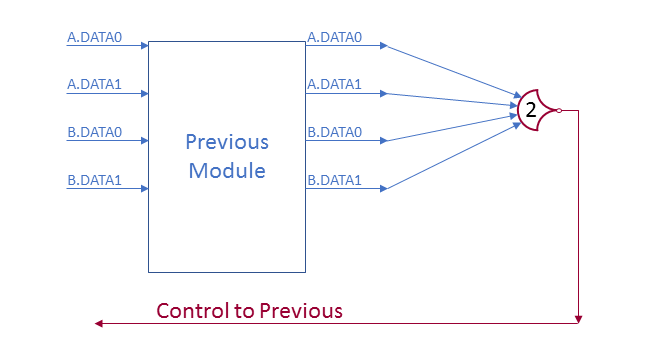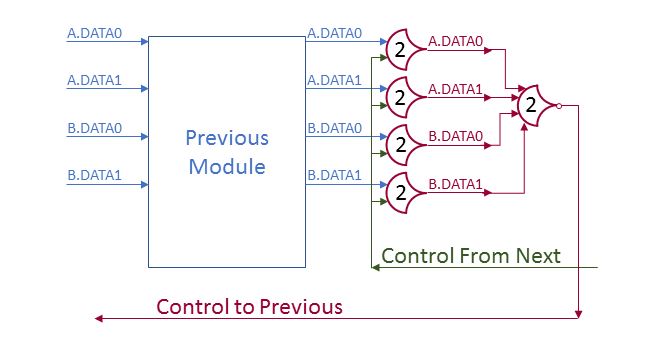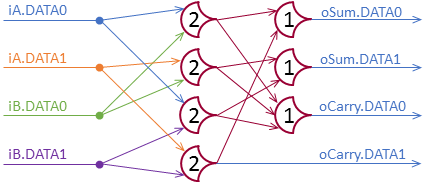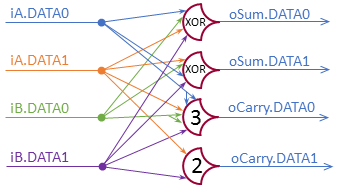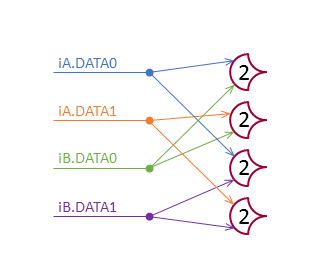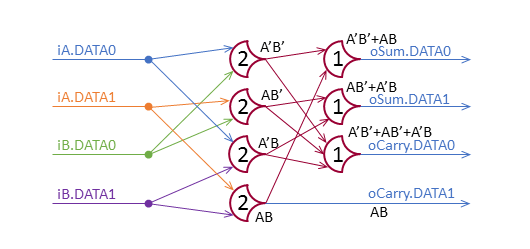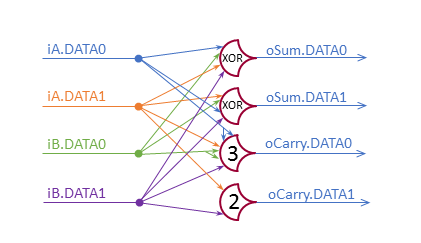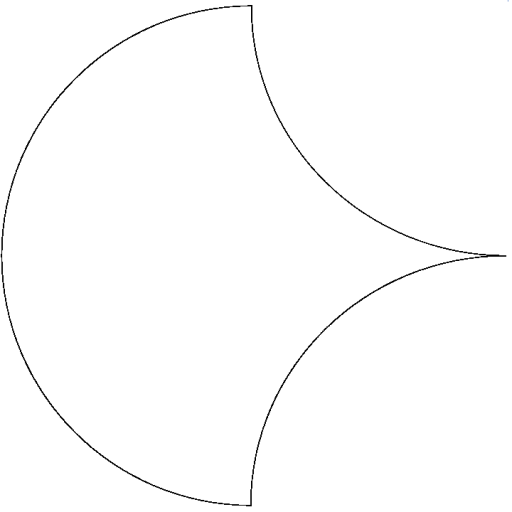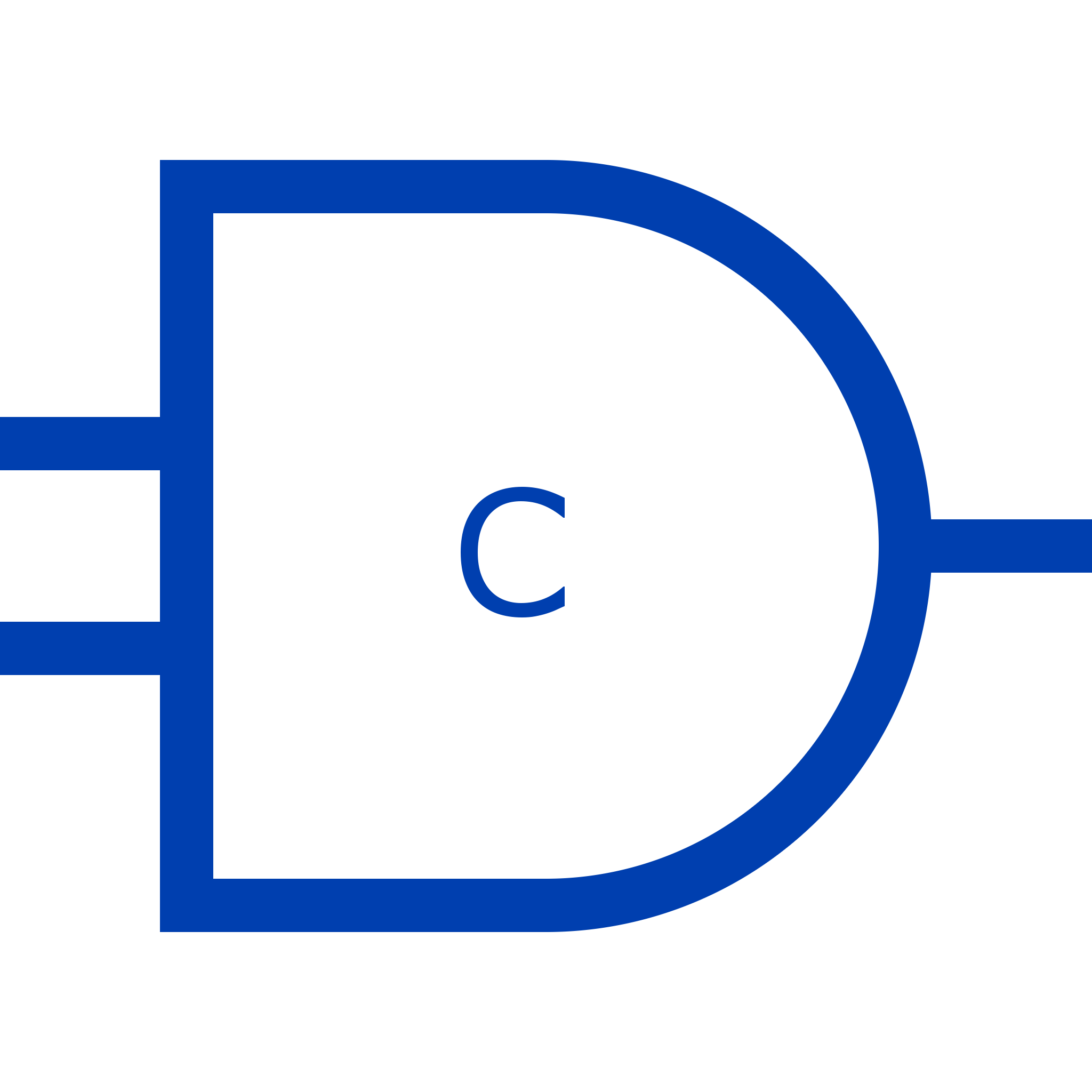Design Recap
The circuit from my last post:
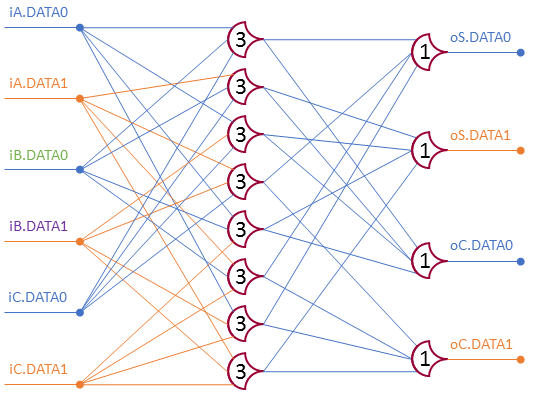
oS.1:
TH12(
TH22(
TH13(iA.1, iB.1, iC.1), -- 1 <= NumBits
TH23(iA.0, iB.0, iC.0)), -- NumBits < 2
TH33(iA.1, iB.1, iC.1))); -- 3 <= NumBits
oS.0:
TH12(
TH33(iA.0, iB.0, iC.0), -- NumBits < 1
TH22(
TH23(iA.1, iB.1, iC.1), -- 2 <= NumBits
TH13(iA.0, iA.0, iA.0)); -- NumBits < 3
oC.1: TH23(iA.1, iB.1, iC.1) -- 2 <= NumBits
oC.0: TH23(iA.0, iB.0, iC.0) -- NumBits < 2
Optimized
The structural VHDL implementation:
library ieee;
use ieee.std_logic_1164.all;
use ieee.numeric_std.all;
use work.ncl.all;
entity FullAdder is
port(iC : in ncl_pair;
a : in ncl_pair;
b : in ncl_pair;
oS : out ncl_pair;
oC : out ncl_pair);
end FullAdder;
architecture structural of FullAdder is
type first_layer is array (integer range <>) of std_logic_vector(0 to 2);
signal first_layer_inputs : first_layer(0 to 7);
signal intermediate : std_logic_vector(0 to 7);
signal inputs : ncl_pair_vector(0 to 2);
begin
inputs(2) <= a;
inputs(1) <= b;
inputs(0) <= iC;
input_layer: for i in 0 to 7 generate
bits: for ibit in 0 to 2 generate
Input0Selection: if (to_unsigned(2**iBit, 3) and to_unsigned(i, 3)) = 0 generate
first_layer_inputs(i)(iBit) <= inputs(iBit).Data0;
end generate;
Input1Selection: if (to_unsigned(2**iBit, 3) and to_unsigned(i, 3)) > 0 generate
first_layer_inputs(i)(iBit) <= inputs(iBit).Data1;
end generate;
end generate;
gate: THmn
generic map(M => 3, N => 3)
port map(inputs => first_layer_inputs(i),
output => intermediate(i));
end generate;
oS0: THmn
generic map(M => 1, N => 4)
port map(inputs(0) => intermediate(0),
inputs(1) => intermediate(3),
inputs(2) => intermediate(5),
inputs(3) => intermediate(6),
output => oS.DATA0);
oS1: THmn
generic map(M => 1, N => 4)
port map(inputs(0) => intermediate(1),
inputs(1) => intermediate(2),
inputs(2) => intermediate(4),
inputs(3) => intermediate(7),
output => oS.DATA1);
oC0: THmn
generic map(M => 1, N => 4)
port map(inputs(0) => intermediate(0),
inputs(1) => intermediate(1),
inputs(2) => intermediate(2),
inputs(3) => intermediate(4),
output => oC.DATA0);
oC1: THmn
generic map(M => 1, N => 4)
port map(inputs(0) => intermediate(3),
inputs(1) => intermediate(5),
inputs(2) => intermediate(6),
inputs(3) => intermediate(7),
output => oC.DATA1);
end structural;
architecture optimized of FullAdder is
signal sLT2 : std_logic;
signal sLT3 : std_logic;
signal sGE2 : std_logic;
signal sGE1 : std_logic;
signal sEQ3 : std_logic;
signal sEQ2 : std_logic;
signal sEQ1 : std_logic;
signal sEQ0 : std_logic;
begin
LT2: THmn
generic map(M => 2, N => 3)
port map(inputs(0) => a.DATA0,
inputs(1) => b.DATA0,
inputs(2) => iC.DATA0,
output => sLT2);
GE2: THmn
generic map(M => 2, N => 3)
port map(inputs(0) => a.DATA1,
inputs(1) => b.DATA1,
inputs(2) => iC.DATA1,
output => sGE2);
GE1: THmn
generic map(M => 1, N => 3)
port map(inputs(0) => a.DATA1,
inputs(1) => b.DATA1,
inputs(2) => iC.DATA1,
output => sGE1);
EQ1: THmn
generic map(M => 2, N => 2)
port map(inputs(0) => sGE1,
inputs(1) => sLT2,
output => sEQ1);
EQ3: THmn
generic map(M => 3, N => 3)
port map(inputs(0) => a.DATA1,
inputs(1) => b.DATA1,
inputs(2) => iC.DATA1,
output => sEQ3);
S1: THmn
generic map(M => 1, N => 2)
port map(inputs(0) => sEQ1,
inputs(1) => sEQ3,
output => oS.DATA1);
EQ0: THmn
generic map(M => 3, N => 3)
port map(inputs(0) => a.DATA0,
inputs(1) => b.DATA0,
inputs(2) => iC.DATA0,
output => sEQ0);
LT3: THmn
generic map(M => 1, N => 3)
port map(inputs(0) => a.DATA0,
inputs(1) => b.DATA0,
inputs(2) => iC.DATA0,
output => sLT3);
EQ2: THmn
generic map(M => 2, N => 2)
port map(inputs(0) => sGE2,
inputs(1) => sLT3,
output => sEQ2);
S0: THmn
generic map(M => 1, N => 2)
port map(inputs(0) => sEQ2,
inputs(1) => sEQ0,
output => oS.DATA0);
oC.DATA0 <= sLT2;
oC.DATA1 <= sGE2;
end optimized;
This VHDL implementation of the the un-optimized design uses generic loops to setup the first layer (the first layer uses all combinations of group values). The second layer is set up manually.
The optimized design’s signals are named in terms of relations Greater or Equal to #, Less Than #, and EQual to #. So sEQ1 is asserted when 1 input group is set to 1, and sGE2 is asserted when at least 2 input groups are set to 1.
Testing
The test script runs through all combinations of inputs. I ran the tests with both versions. Here’s the result, no surprises really.




